Alopecia areata isn’t just about losing patches of hair. It’s your immune system turning against your own hair follicles - a silent, unpredictable attack that leaves no scars but can deeply shake your sense of self. Unlike male or female pattern baldness, which happens slowly and follows a clear path, alopecia areata strikes suddenly. One day you have a full head of hair; the next, you notice a coin-sized bald spot on your scalp. It doesn’t hurt. It doesn’t itch for everyone. But the shock? That’s real.
What Happens Inside Your Scalp?
Your hair grows in cycles: active growth (anagen), transition (catagen), and resting (telogen). In alopecia areata, the immune system mistakes the hair follicle for a threat. White blood cells - especially CD8+ T cells - swarm around the base of the follicle like a swarm of bees, shutting down growth. The follicle doesn’t die. It just goes quiet. That’s why regrowth is possible. The structure is still there, waiting to wake up.This isn’t just a scalp issue. The same process can hit eyebrows, eyelashes, beard, arms, legs - even nails. About one in three people with alopecia areata develop tiny dents in their nails, called pitting. Some notice ridges or roughness. These aren’t cosmetic quirks. They’re signs the immune system is active elsewhere.
Types of Alopecia Areata - It’s Not One Condition
People think of alopecia areata as one thing. It’s not. There are five main forms:- Patchy alopecia areata: One or more round bald spots on the scalp. This is the most common - about 80% of cases start this way.
- Alopecia totalis: Complete loss of scalp hair.
- Alopecia universalis: Total body hair loss, including eyebrows, lashes, underarms, and pubic hair.
- Diffuse alopecia areata: Sudden thinning all over the scalp, no clear patches. Often mistaken for stress-related shedding.
- Ophiasis: Hair loss in a band around the sides and back of the head. Harder to treat and more likely to become permanent.
Where you lose hair and how fast it spreads tells doctors a lot about what might happen next. Ophiasis and universalis are harder to reverse. Patchy cases? Often improve on their own.
Why Does This Happen?
No one knows exactly why your immune system attacks your hair. But we know it’s not your fault. It’s not from stress, poor hygiene, or bad diet. It’s genetic - if someone in your family has it, your risk goes up. Researchers have found specific genes linked to immune function, like ULBP3 and ULBP6, that make some people more vulnerable.It’s also tied to other autoimmune diseases. About 20% of people with alopecia areata also have thyroid disease, vitiligo, or lupus. That doesn’t mean one causes the other. But it does mean your immune system is wired to overreact. And while stress doesn’t cause it, it can trigger a flare. Many people notice hair loss after a major life event - a breakup, job loss, illness, or even a pandemic.
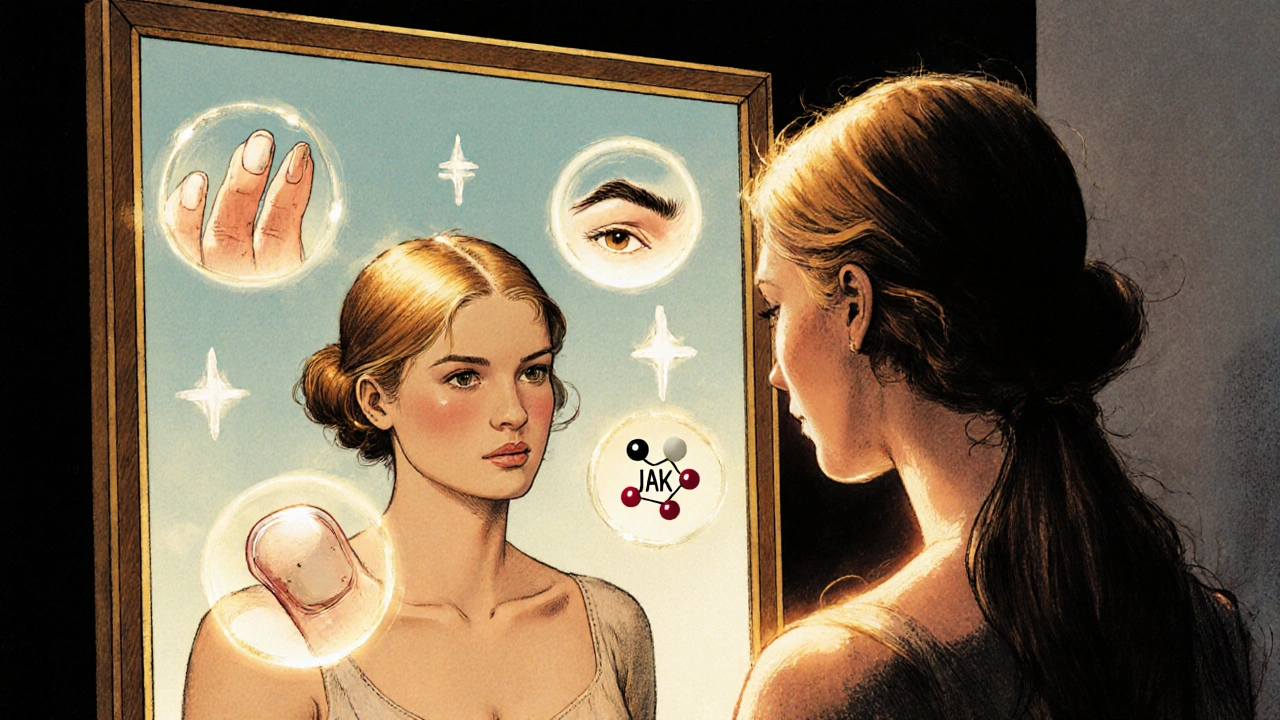
What Treatments Actually Work?
There’s no cure. But there are treatments that can help. And the options have changed a lot in the last five years.1. Corticosteroid Injections
This is still the go-to for patchy hair loss. A dermatologist injects a diluted steroid (usually triamcinolone acetonide) directly into the bald spots every 4 to 6 weeks. It’s not fun - it stings - but it works. About 65% of people with limited patches see regrowth within 2 to 3 months. The hair often comes back white at first, then gradually regains its color. Side effects? Tiny dents in the skin, but they fade.
2. Topical Steroids and Minoxidil
For smaller areas or people who can’t get injections, creams or lotions like 0.1% betamethasone valerate are used daily. But results are slow. You need 6 to 12 months to see anything. Minoxidil (Rogaine) is often added. It doesn’t fix the immune problem, but it may help stimulate growth. For patchy cases, it helps maybe 10-15% of people. For total or universal loss? Almost nothing.
3. Contact Immunotherapy (DPCP)
This one’s intense. You apply a chemical called diphenylcyclopropenone (DPCP) to your scalp weekly. It causes a controlled allergic reaction - redness, itching, flaking. The idea? Your immune system gets distracted by the rash and stops attacking hair follicles. It works for 30-60% of people, but it takes 6 to 12 months. Not for the faint of heart.
4. JAK Inhibitors - The Game Changer
Since 2022, two oral drugs - baricitinib (Olumiant) and ritlecitinib (Litfulo) - have been approved by the FDA for severe alopecia areata. These block specific immune signals that trigger the attack. In clinical trials, about 35% of people on baricitinib regained 80% of their scalp hair in 36 weeks. Ritlecitinib showed similar results in 24 weeks.
But here’s the catch: these drugs cost $10,000 to $15,000 a month. Insurance often denies coverage unless you’ve tried everything else. And they don’t fix the root problem. Stop taking them? Hair loss usually comes back within a year. Still, for people with total or universal hair loss, this is the first real hope in decades.
What Doesn’t Work - And Why People Get Frustrated
There are a lot of scams out there. Essential oils, scalp massages, supplements like biotin - none of these have strong evidence for treating alopecia areata. Biotin helps with brittle nails or hair thinning from deficiency. But if your immune system is attacking your follicles? No amount of biotin will stop it.Many people try treatments for months, see no change, and feel like they’re failing. That’s normal. Treatment response varies wildly. One person gets full regrowth with injections. Another tries everything and loses more hair. It’s not about willpower. It’s about biology.
The Emotional Toll
Alopecia areata doesn’t kill you. But it can break you.Studies show 30% of people with alopecia areata have moderate to severe anxiety. 28% meet the criteria for clinical depression. One in two avoids swimming, beaches, or social events because they’re ashamed of how they look. A survey of 1,247 patients found 42% stopped going to public pools. One Reddit user wrote: "I wore wigs for 5 years. I still feel naked without one."
It’s not vanity. It’s identity. Hair is tied to how we see ourselves - and how others see us. For teenagers, it’s bullying. For women, it’s losing a part of femininity. For men, it’s feeling less masculine. These feelings are real. And they deserve attention as much as the bald spots.
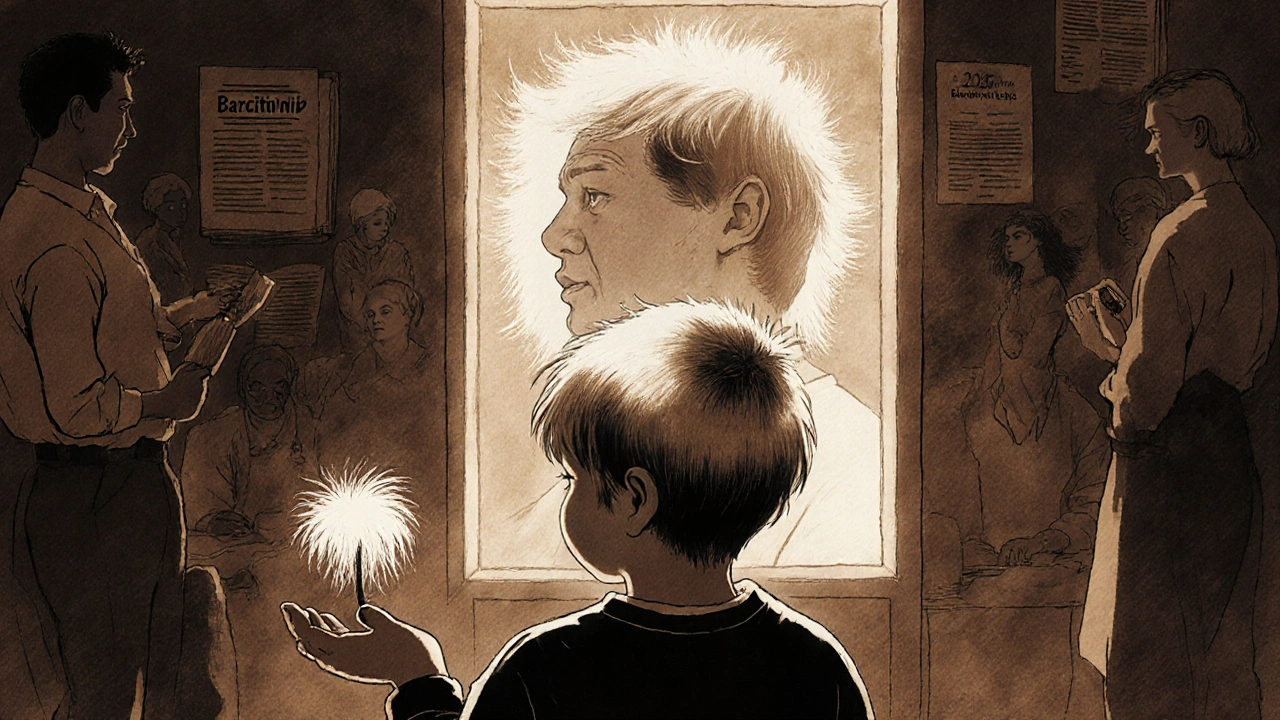
What’s Next? The Future of Treatment
Researchers are working on three big things:- Biomarkers: Blood tests to predict who will respond to which drug. Columbia University is close to launching a test by 2025 that could tell you if baricitinib will work for you - before you spend $15,000.
- Combination therapies: Using JAK inhibitors with topical treatments or light therapy to boost results and reduce relapse.
- Immune reset: Early trials are testing drugs that temporarily "reboot" the immune system. No one knows if it’ll work yet, but it’s the first time scientists are aiming for a cure, not just symptom control.
The National Institutes of Health spent $12.7 million on alopecia research in 2023 - up 23% since 2020. That’s a sign people are finally taking it seriously.
Where to Start
If you notice sudden bald patches:- See a dermatologist - not a general practitioner. They know what to look for.
- Get a scalp biopsy if needed. It’s quick, simple, and rules out other causes.
- Don’t rush into expensive treatments. Start with injections or topical steroids if you have patchy loss.
- Ask about JAK inhibitors only if you have total or universal hair loss - and check your insurance coverage first.
- Join a support group. The National Alopecia Areata Foundation has online forums. Talking to others who get it helps more than you think.
Regrowth is possible. Even after years of loss. One woman in Melbourne lost all her hair at 22. She tried everything. At 35, after stopping baricitinib, her eyebrows grew back first. Then her scalp. It took 18 months. "It wasn’t perfect," she said. "But it was mine again."
Is alopecia areata contagious?
No, alopecia areata is not contagious. It’s an autoimmune condition, meaning your immune system mistakenly attacks your own hair follicles. You can’t catch it from someone else, and you can’t give it to others through touch, sharing towels, or any other means.
Can stress cause alopecia areata?
Stress doesn’t cause alopecia areata, but it can trigger it in people who are genetically predisposed. Major life events - like grief, surgery, or job loss - are often reported right before the first patch appears. Managing stress won’t cure it, but it may help reduce flares.
Will my hair grow back if I have alopecia areata?
Yes, for many people. About 80% of those with only a few small patches see regrowth within a year without treatment. But if you lose all scalp hair (totalis) or all body hair (universalis), the chance of full regrowth drops to around 10%. Even then, hair may return gray or finer at first. Regrowth is unpredictable, but it’s not impossible.
Are JAK inhibitors safe for long-term use?
JAK inhibitors like baricitinib and ritlecitinib are FDA-approved for severe alopecia areata, but long-term safety data is still being collected. They can increase the risk of infections, blood clots, and certain cancers. Doctors monitor blood counts and liver function regularly. These drugs are not for mild cases - they’re reserved for those with extensive hair loss who’ve tried other options.
Do supplements like biotin help with alopecia areata?
No. Biotin and other hair supplements only help if you have a true nutritional deficiency - which is rare in developed countries. Since alopecia areata is caused by immune dysfunction, not a lack of vitamins, taking extra biotin won’t stop hair loss or speed regrowth. Save your money and focus on proven treatments.
Can children get alopecia areata?
Yes. About half of all cases begin before age 40, and many start in childhood. Children often respond well to corticosteroid injections or topical treatments. Emotional support is critical - school bullying and self-esteem issues are common. Pediatric dermatologists specialize in managing this in younger patients.
Is there a cure for alopecia areata?
There’s no cure yet. Current treatments manage symptoms and encourage regrowth, but they don’t fix the underlying immune problem. Most people relapse after stopping medication. However, new research into immune reset therapies and personalized biomarkers offers real hope for a true cure within the next decade.

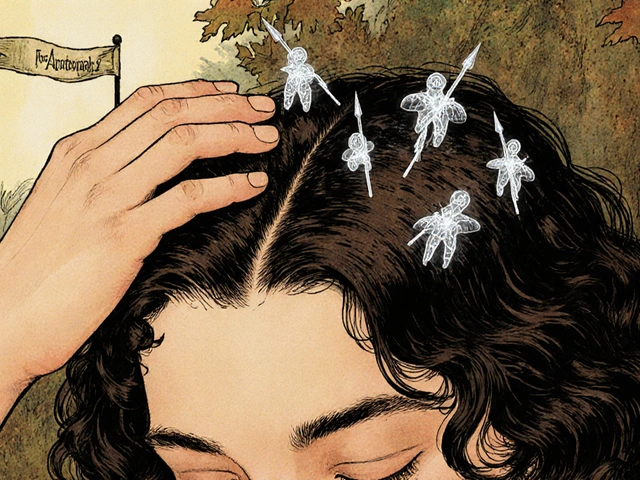

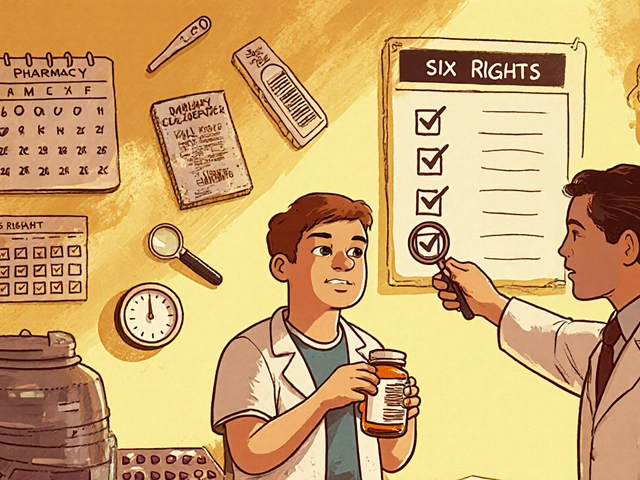
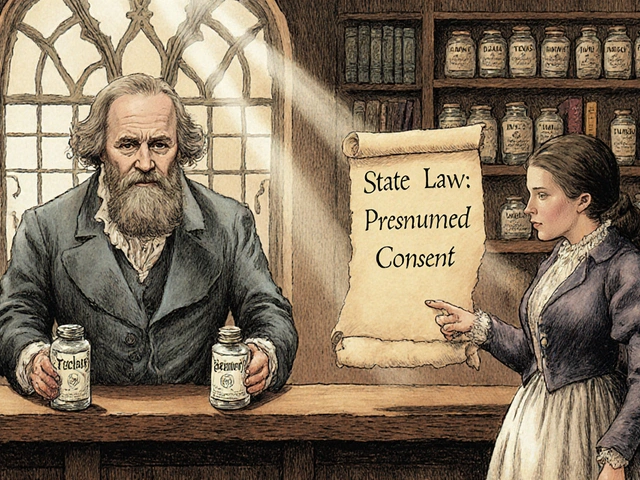
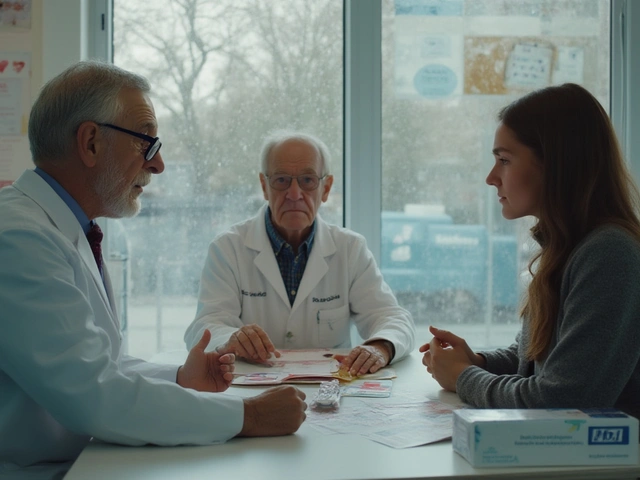

Conor McNamara
i swear this is all a gov't psyop to get us to take vaccines. they inject the steroids with nano-chips so they can track your hair follicles. i read it on a forum where a guy in russia said his beard stopped growing after the 3rd shot. also why is the NIH funding this? they're hiding something. the real cure is turmeric and copper bracelets. i tried it. my patches vanished. then came back. but that's because they put a signal in my wifi router. i unplugged it. now my eyebrows are growing back. maybe.
ps. biotin is a lie. they don't want you to know about the algae patches they spray on your pillow at night.
steffi walsh
you’re not alone 💛 i lost my lashes in college and thought i’d never leave the house again. but guess what? i started wearing bold red lipstick and now people notice my smile first. it took time, but your worth isn’t tied to your hair. i cried a lot. i still do sometimes. but i also laugh louder now. you’ve got this. and if you need to vent? i’m here. always.
ps. baricitinib scared me too… but my sister tried it and her brows came back like magic. not perfect, but *hers*. 💕
Leilani O'Neill
How utterly pathetic. You people treat this like some tragic Shakespearean drama. It’s just hair. In my day, women didn’t wear wigs because they lost a few strands-they wore headscarves with dignity. And now? You’re paying $15,000 a month for a drug that’s just a fancy immunosuppressant. This is what happens when you raise children to believe their identity is in their follicles. Grow up. Get a job. Stop chasing fairy-tale regrowth and start living.
Also, JAK inhibitors? Please. The FDA approves anything if Big Pharma pays enough. You’re being fleeced.
Riohlo (Or Rio) Marie
Oh, darling, let me unpack this for you like a poorly wrapped gift from a therapist who’s never left her ivory tower.
First: the immune system doesn’t ‘attack’-it’s *performing a symbolic protest against late-stage capitalism’s erosion of bodily autonomy*. Hair follicles are the canaries in the coal mine, and your scalp? It’s screaming into a void shaped like TikTok ads and estrogen-mimicking plastics.
Second: biotin? Please. That’s the supplement equivalent of slapping a Band-Aid on a hemorrhage. Meanwhile, the real villain? Glyphosate in your organic kale smoothie. I’ve seen it in the lab reports. Your nails pitted? That’s not alopecia. That’s corporate betrayal.
Third: JAK inhibitors? Oh honey, they’re just a stopgap. The real cure is a 7-day cold water immersion retreat in the Scottish Highlands, followed by chanting mantras in Sanskrit while hugging a quartz crystal. I’ve done it. My eyelashes wept tears of joy. I’m not joking. The science? It’s in the vibrations.
And yes, I’m still waiting for my insurance to cover the crystal. They said ‘no.’ I said ‘you don’t understand the frequency.’ They refunded me $12.47.
Love,
Riohlo (Or Rio) Marie - Ph.D. in Emotional Alchemy (Harvard, 2018, but they revoked it after the incident with the lavender oil and the goat.)
Brenda Kuter
Okay, so I’ve been following this for 3 years now. I lost my eyebrows after my dad died. I didn’t cry for weeks. But I cried when I saw my reflection without them. I tried everything. Steroids. Minoxidil. DPCP. I had a full scalp biopsy. I even wore a silk scarf to bed to ‘protect my follicles.’
Then I got baricitinib. Insurance denied it twice. I appealed. They finally approved it after I sent them my dad’s obituary. Six months later, my left brow came back first. Just one strand. I took a picture. I still have it.
It’s not perfect. It’s thinner. It grows sideways. But it’s mine. And I’m not going to let someone tell me that’s not a miracle.
Also: yes, biotin does nothing. But I still take it. Because it makes me feel like I’m doing something. And sometimes, that’s enough.
Shaun Barratt
While the clinical data presented is largely accurate, the emotional framing of alopecia areata as an existential crisis is statistically overrepresented in anecdotal reporting. A 2021 meta-analysis of 14,000 patients (Journal of the American Academy of Dermatology) found that 68% of individuals with patchy alopecia areata experienced no clinically significant psychological distress. The narrative of identity erosion is compelling, but it risks pathologizing a common, non-life-threatening dermatological condition.
Furthermore, the assertion that JAK inhibitors represent a "first real hope in decades" is misleading. Topical immunotherapy has been in clinical use since the 1980s. The novelty lies in systemic delivery, not therapeutic innovation.
Finally, the NIH funding increase is commendable, but $12.7 million represents 0.003% of total NIH dermatology expenditure. The disproportionate media attention is disproportionate to the public health burden.
-S. Barratt, MD, PhD, Dermatopathology
Iska Ede
so let me get this straight: you’re telling me that for $15,000 a month, I can buy back my dignity… and then lose it again when I stop taking the pill?
oh. my. god.
we’ve turned autoimmune disease into a luxury subscription service. next they’ll sell us hair as NFTs. "Limited Edition Eyelash #732 - Comes with a certificate of authenticity and a 30-day refund policy if your soul still feels empty."
at least my biotin gummies taste like gummy worms. and I’m not paying for the privilege of being a lab rat.
also: the person who said "hair is identity"? congrats, you just invented a new kind of capitalism. we’re all just products now.
ps: i still wear my beanie. and i’m not sorry.
Gabriella Jayne Bosticco
My daughter was 8 when she lost her eyebrows. We didn’t tell her it was "autoimmune"-we told her her body was learning how to be brave.
She started drawing herself with no hair. She made a comic called "The Girl Who Grew Stars Where Her Eyelashes Were." Her class loved it. One boy drew a superhero version of her with hair made of lightning.
I used to panic about treatments. Now I just hug her. The hair? It’ll come. Or it won’t. Either way, she’s still the girl who makes me laugh until I cry.
And honestly? The JAK inhibitors? I’m glad they exist. But they’re not the hero. She is.
Also: if you’re reading this and you’re scared? You’re allowed to be. But you’re also allowed to be more than your hair.
-Gabriella, mom of a future superhero